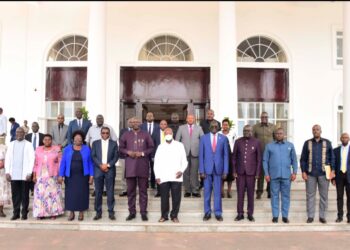When rumours started coming through that Crane Bank was due to close shop in Uganda, it was none other than Bank of Uganda that refuted the reports. However, the central bank finally turned against word and announced in a statement signed by none other than the governor, E. Tumusiime-Mutebile (Prof) that “BANK OF UGANDA TAKES OVER MANAGEMENT OF CRANE BANK LIMITED”.
That was on October 20, 2016.
The governor, which we now understand was actually his deputy Louis Kasekende, wrote, “In exercise of its powers under Section 87(3), 88(1)(a) & (b) of the Financial Institutions Act 2004, Bank of Uganda has effective today, Thursday October 20, 2016, taken over the management of Crane Bank Limited.”
The statement went on, “This action has been taken upon a determination by Bank of Uganda that Crane Bank Limited is a significantly undercapitalised institution as defined by law, poses a systemic risk to the stability of the financial system and that the continuation of Crane Bank’s activities in its current form is detrimental to the interests of its depositors.
“Accordingly, Bank of Uganda has appointed a statutory manager of the affairs of Crane Bank Limited and suspended the Board of Directors of Crane Bank Limited. Bank of Uganda assures the public that Crane Bank Limited will remain open and its operations will continue normally, but under the management and control of Bank of Uganda. Bank of Uganda further reassures the public that it will continue to protect depositors’ interests and maintain the stability of the financial sector.”
It is one year and five months since the announcement which brought down the biggest indigenous bank in the country. All we know about Bank of Uganda, Crane Bank, and other defunct banks, is much more different.
A lot has been said and written since, but again, not so much has been brought out by a Parliament probe like one by Abdu Katuntu. No wonder, Bank of Uganda knew it was this rotten when it refused the Auditor General to audit it, until Speaker Kadaga Rebecca ordered so. This is the audit Mr Katuntu’s committee played out before cameras for all to see.

At the end of the day, the parliamentary probe report has indicted Bank of Uganda in the illegal closure of not only Crane Bank limited but also six other banks. The others are Teefe Bank (1993), International Credit Bank Ltd (1998), Greenland Bank (1999), The Co-operative Bank (1999), National Bank of Commerce (2012), Global Trust Bank (2014) and the sale of Crane Bank Ltd (CBL) to dfcu (2016).
Whereas the Parliamentary committee has not passed tough recommendations, a lot of credit has been given to them for exposing the rot in the Bank of Uganda, with a few of causing reforms at the institution which serves as the heart of the economy.
However, a lot of damage has been done, as before we held BoU with so much awe and respect.
How it all started.
After the fall of Crane Bank, there were a lot of behind the scene negotiations. Bank of Uganda had managed to arm-twist Crane Bank’s major shareholder Sudhir Ruparelia to concede more than his bank which had been closed to a tune of Sh400 billion. It meant losing several of his premium properties.
Word has it that actually Sudhir pleaded to be given time and again, deposited collateral in exchange for immunity from threats of prosecution.
The deal was inked.
Since greed has no limits, in the first week of July of 2017, New Vision, unleashed a series of article from a contestable forensic audit of Crane Bank, then in receivership in which Bank of Uganda alleged that Sudhir siphoned up to sh400 billion from his bank.

“Sudhir embezzled over sh400 b, says Bank of Uganda,” shouted one of the headlines.
The series of articles were meant to bias the public opinion ahead of the court battle that Bank of Uganda officials and its lawyers had planned would leave the businessman no option but cede everything he had to pay up. It is now understood that the tactics were to benefit officials and lawyers who took commissions from every manauvre they made, and this was not just with Crane Bank.
Meanwhile, against the memorandum of understanding between the interested parties, ill-advised move by lawyers that we now know as conflicted after the Cosase probe, was the turning point for Bank of Uganda’s sanctity.
From its seat as the high priest of Uganda’s economy, the moment Sudhir Ruparelia stepped in court with his lawyers, Kampala Associated Advocates (KAA), the rest is history. Tables turned, and Sudhir has since demystified Bank of Uganda, DFCU, and MMKAS lawyers led by Timothy Kanyerezi Masembe and AF Mpanga led by David Mpanga.
Since then Sudhir has taken on dfcu bank in court which he says ran away with his 46 branches which he maintains are under his Meera Investments. He is demanding rent arrears in the excess of sh2.9 billion, although this money is accumulating to date.
From every turn, BoU officials started regretting why they closed Crane Bank, which the Cosase probe has showed has started recovering from its crisis, despite BoU refusal to inject money to bail it out.
As the blame game went on in the precincts of the corridors of BoU, Governor Mutebile returned to office determined to regain control of affairs. However, the people he had left the Bank to run, had gained much more notoriety and powers.
However, in a February 2018 shakeup, Mutebile announced major changes within the top structures of the bank, retiring Justine Bagyenda, the long serving executive director in charge of supervision, five months before her retirement. He also reshuffled 24 members of staff.
A statement from Bank of Uganda (BoU) said Ms Bagyenda who was replaced by Tumubweine Twinemanzi was retired early to allow her to process her handover.
However, the changes didn’t come without a fight. Bagyenda and her followers took the battle to the Inspectorate of Government Irene Mulyagonja who started back and forth letters with Mutebile. Mutebile said he was self-regulating, but Mulyagonja stood her ground. She stayed the status quo. Mutebile lost the plot as President Museveni intervened to stop the public attacks. The writing was on the wall. The glue that kept BoU strong was no more holding.

The central bank has since been in the news facing the deepest scrutiny of its operations.
Even if Cosase didn’t recommend tough measures on abusers of powers, at least the records are clear. Mutebile left the bank in auto pilot when he took a sick leave in 2015/16, and the repercussions have been grave.
Dogs indeed had invaded the sanctuary of the Bank of Uganda, and they didn’t stop stealing small meat, they literally looted banks.
Bagyenda, who has since been cleared by a select committee of parliament for accumulating wealth using her position, was reported in the media that she had Shs20 billion stashed in several commercial banks. The banks confirmed the reports by apologising to Ms Bagyenda for the leakage of her private information and even fired their officers who reportedly compromised their systems.
After Bagyenda, it was Mr Kasekende.
It was reported that the deputy governor had properties worth sh21 billion. Mr Kasekende protested the allegations and again a select committee of two Cosase members cleaned him of wrong doing.
The Bank of Uganda probe has kept newsmen on tenterhooks and today as the report is debated by parliament, it is clear in everyone’s mind that the Cosase did a good job to probe, but, gave weak recommendations. Everyone expected heads to roll, including recommending firing, prosecution and forced return of the wealth looted from the central banks from culpable officials.
Last Thursday, Cosase concluded that officials at Bank of Uganda (BoU) had made many “questionable decisions” and contravened sections of the Financial Institutions Act (FIS) during the closure and sale of seven commercial banks.
Among officials facing the line of fire include; Governor Mutebile, Mr Kasekende, Benedict Sekabira, the Director Financial Markets Development Coordination (FMDC), Timothy Sekirayi, Grace Ndyareeba, Margaret Kasule, Titus Mulindwa, William Kasozi and Justine Bagyenda who has since retired from the central bank.
Mr Katuntu committee’s findings state that BoU officials were closing and selling the banks on the same day as was with the case of the National Bank of Commerce. They also appointed auditors after the sale and failed to compile inventory reports, which meant that BoU did not know the value of institutions they were selling. For example, BoU invited dfcu Bank to table a bid for Crane Bank on December 9, 2016, dfcu submitted the bid on December 20, and auditors produced an inventory for Crane Bank on December 21, a day after the bid was submitted.
The sale of banks was fishy. And indeed, BoU was stinking, just as its officials are stinking rich.
Do you have a story in your community or an opinion to share with us: Email us at editorial@watchdoguganda.com











